There are 11 species of turtles in Massachusetts, and if you are incredibly lucky, you could see one of 4 sea turtles off the coast. Of the turtles found in the state, 10 are native, while one is an introduced species.
Whether it’s a pond, small stream, or sprawling lake, you can bet there are turtles in or around the area. Some turtles even live mostly on land.
If you are interested in the types of turtles in this state, keep reading as we go over them all. We will include information about each species, and how to tell one type from another.
Table of Contents
Turtles in Massachusetts
1. Blanding’s Turtle

- Experience Level: Intermediate
- Family: Emydidae
- Scientific Name: Emydoidea blandingii
- Other Names: N/A
- Adult Size: 5 to 8 inches (12.5 to 20 cm)
- Life Span: Up to 80 years
- Average Price Range: $300 to $450
- Conservation Status: Endangered
Blanding’s turtles are known for their bright yellow underside of their chin. They are sometimes called the “turtle that smiles.” Aside from the wide yellow streak, you can recognize Blanding’s turtles by their high domed, black shells that sometimes have a smattering of speckles.
In younger turtles, these speckles are brighter, because they fade with age. The plastron (bottom part of the shell) is yellow with larger black spots. It’s also hinged, allowing the turtle to partially close the shell when it withdraws.
Shallow bodies of water such as slow-moving streams and ponds are a preferred habitat of Blanding’s turtles. Though they spend a lot of time in the water, they also bask frequently and will traverse long distances in search of a proper nesting site.
These turtles are one of the longest lived turtles in the world. Scientists are eager to study this species because they don’t age like most other organisms. Some females are still able to lay eggs up into their 7th or 8th decade.
Blanding’s turtles are omnivores though they prefer to eat crayfish and other crustaceans. They will also feed on fish, tadpoles, insects, worms, and vegetation.
2. Bog Turtle
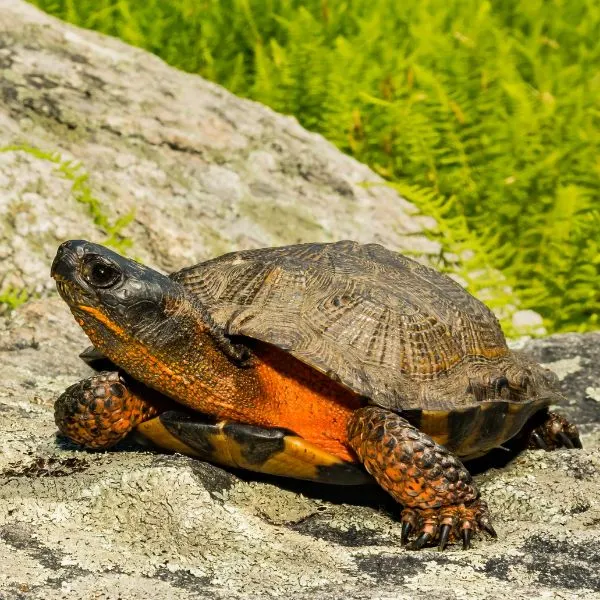
- Experience Level: *Expert
- Family: Emydidae
- Scientific Name: Glyptemys muhlenbergii
- Other Names: Muhlenberg’s turtle
- Adult Size: 3.5 to 5 inches (9 to 12.5 cm)
- Life Span: Up to 40 years
- Average Price Range: Illegal to own, Federally protected species
- Conservation Status: Endangered
The Bog turtle is the smallest species of turtle living in North America as well as the rarest found in the United States. They are so small and so cute they are considered a flagship species.
What does that mean? Bog turtles with their diminished size and cute appearance have many people wanting to save them. Since they need wetlands, bogs, and marshes to survive, saving these turtles means saving wetland habitats.
Not only is habitat destruction affecting these turtles, but poaching for the pet trade, and low birth rates contribute to their low numbers. Bog turtles only lay 2 to 3 eggs per year.
Since they are so small, many predators feed on them, especially when they are hatchlings.
If you happen to see these miniscule turtles, you’ll be able to identify them not just because they average 3 to 4 inches, but because they have large orange or yellow blotches on the side of their head, behind their eyes.
Their domed shell and skin are black, and their eyes are very dark. When observed from above you will notice that the front of the shell is slightly more narrow than the rear.
Bog turtles are omnivores and will feed on slugs, worms, insects, and vegetation.
Terrapins in Massachusetts
3. Northern Diamondback Terrapin

- Experience Level: Beginner to Intermediate
- Family: Emydidae
- Scientific Name: Malaclemys terrapin terrapin
- Other Names: Diamond-backed terrapin
- Adult Size: 4.5 to 9 inches (11.5 to 23 cm)
- Life Span: 25 to 40 years
- Average Price Range: $250 to $600
- Conservation Status: Special concern in Connecticut
Diamondback terrapins spend most of their lives in brackish water—a mixture of salt and freshwater. Though there are other species of turtles that can handle short periods in brackish water, the Diamondback is the only one that lives full time in this type of habitat.
These turtles are striking with their grey, olive, or brown shells with black, concentric rings, or squiggles on the scutes. Another pretty feature is the speckled white, grey, or nearly black skin, and the appearance of a black mustache on their face. These features make these turtles highly sought after by turtle collectors.
Female Diamondback turtles are bigger and have larger, more bulbous heads. This allows them to eat clams and mussels because they can crack the tough shells. Males are smaller and have to eat softer crustaceans such as smaller crabs and insects.
Diamondback terrapins live in mangrove swamps, estuaries, salt marshes, and lagoons. They have special adaptations that allow their bodies to excrete excess salt buildup.
These turtles eat mostly crustaceans such as shrimp, crabs, clams, and mussels. A few have been observed eating small amounts of vegetation.
Box Turtles in Massachusetts
4. Eastern Box Turtle

- Experience Level: Beginner
- Family: Emydidae
- Scientific Name: Terrapene carolina carolina
- Other Names: Land Turtle
- Adult Size: 4 to 7 inches
- Life Span: 50 to 100 years
- Average Price Range: $260 – $360
- Conservation Status: Michigan, New Hampshire, Massachusetts, and Connecticut—list the animal as a species of special concern, and Maine lists the turtle as endangered.
The Eastern Box turtle has a high domed carapace (the name for the upper part of the shell), and a double hinged plastron. With this adaptation, the turtle can close itself in the shell like a box when it’s threatened.
Their carapace is dark brown or black with yellow, orange, or reddish colors on each scute. Scutes are separate growth plates on a turtle’s shell. The skin and scales on box turtles match the colors on the carapace.
Eastern Box turtles are mostly terrestrial. You’ll often find these little guys wandering around the forest floor, or other damp wetland habitats. They don’t typically enter the water, instead, they will dig into cool mud or under leaf litter to cool off.
While they search their territory for food, they nearly always return to their original nesting site. Box turtles will roam about the length of a football field away, and return.
These turtles are omnivores. They feed on berries, fruit, fungi, carrion (fresher meat, not bodies that are in advanced states of decay), worms, slugs and snails, and various insects.
Musk Turtles in Massachusetts
5. Eastern Musk Turtle
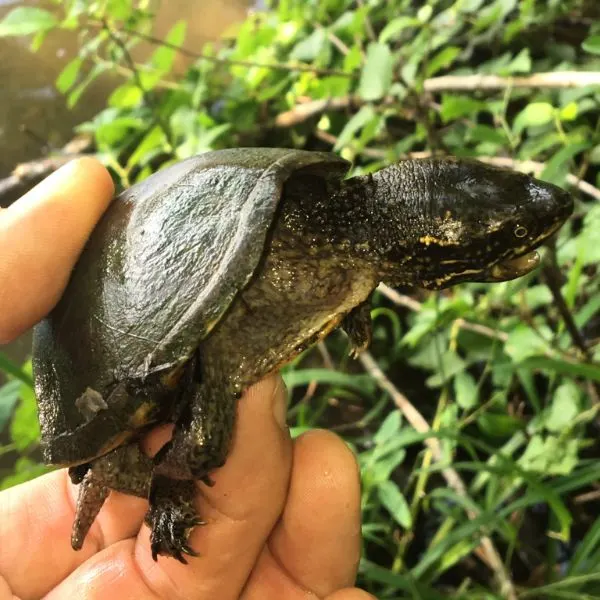
- Experience Level: Intermediate
- Family: Kinosternidae
- Scientific Name: Sternotherus odoratus
- Other Names: Common Musk turtle, Stinkpot
- Adult Size: 4 to 5 inches (10 to 12.5 cm)
- Life Span: 30 to 50 years
- Average Price Range: $30 to $120
- Conservation Status: Least concern
The carapace color of the Eastern Musk turtle or the Stinkpot varies from gray, black, or brown. There are no distinguishing markings on the shell, but the shape resembles an egg. They also have two stripes on either side of their head running from snout to neck.
If you happen to pick this turtle up, you’re likely never going to forget it. They will either try to bite, unleash a powerful stench from their musk glands, or both.
These turtles are often found in shallow waters with a lot of vegetation and muddy bottoms. Ponds, slow streams, drainage ditches, bogs, and swamps are where you’ll find Musk turtles.
You may also find them in the trees. Yes, these turtles are accomplished climbers. When branches dip into the water or touch the ground, the musk turtle may climb it in search of food and a place to bask.
Eastern Mud turtles are omnivores, they will feed on aquatic invertebrates such as leeches, mollusks, and clams. They also eat tadpoles, worms, spiders, fish, algae, and plant matter.
Cooters in Massachusetts
6. Northern Red-bellied Cooter
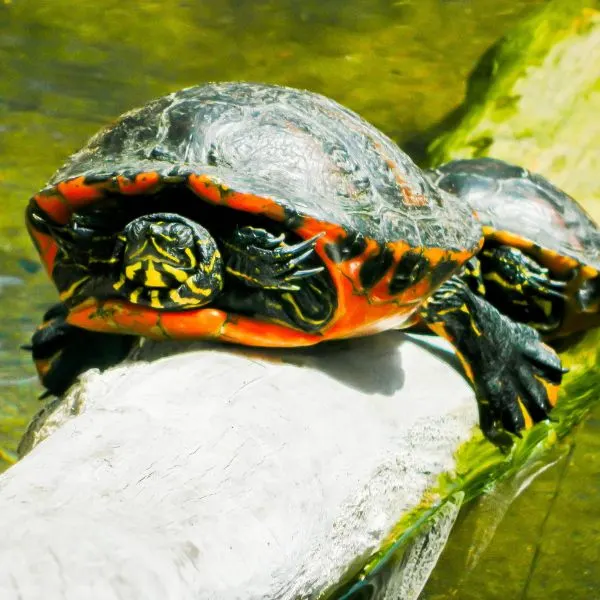
- Experience Level: Beginner to Intermediate
- Family: Emydidae
- Scientific Name: Pseudemys rubriventris
- Other Names: American red-bellied turtle
- Adult Size: Between 8 and 12 inches
- Life Span: Between 40 and 55 years
- Average Price Range: Between $30 and $170
- Conservation Status: Federally near threatened. Endangered in Massachusetts
Northern Red-Bellied Cooters are large aquatic turtles. They have slightly domed, wrinkled-looking shells, though they can sometimes be smooth.
When these turtles hatch, they have a colorful, highly patterned shell, but these colors darken and fade with age. The tell-tale red belly (plastron) never goes away. The skin on these turtles is dark green, brown, or black with yellow or white stripes.
These turtles love to bask, and many turtles will often crowd a small log or rocky outcropping. When they are approached or disturbed though, these turtles will quickly slide back into the water. Red-Bellied Cooters are rather shy.
These turtles can be found in large rivers, marshes, lakes, and ponds with silty, soft bottoms, and copious amounts of vegetation.
Their diet consists of anything living in their habitat. They will feed on tadpoles, aquatic insects, crayfish, fish, and vegetation.
Painted Turtles in Massachusetts
7. Eastern Painted Turtle
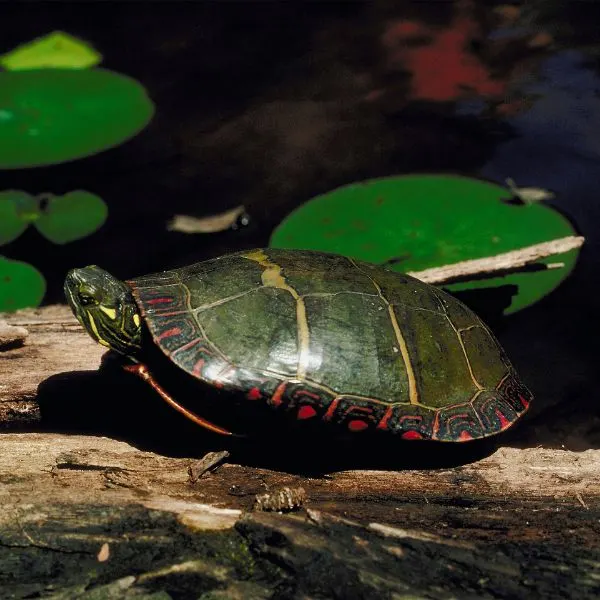
- Experience level: Beginner
- Family: Emydidae
- Scientific Name: Chrysemys picta
- Common Name: Painted Turtle
- Average Adult Size: 4 – 10 inches
- Life Span: 30 – 50 years
- Average Price Range: Between $30 to $150
- Conservation Status: Least Concern
Eastern Painted turtles have smooth, oval shaped carapaces. Their marginal scutes have red crescents on them. The plastron is red or orange with butterfly type patterns along the midline.
Their skin is dark green, brown, or black with yellow or white stripes. The painted turtle’s eyes are also striped. They usually have a dark stripe in the middle, with yellow stripes above and below.
With 4 different subspecies of Painted turtles, these are the most abundant turtles found across the United States. They all look very similar, but if you are able to study the scutes and markings on their heads, you may be able to identify individual subspecies.
In Massachusetts, the only species of Painted turtle is the Eastern. The scutes on the carapace of this species alternate. There are three main rows that line up from front to back, but they alternate if you’re looking at them from one side to the other.
Painted turtles prefer to inhabit shallow streams, bogs, marshes, and other bodies of water with very little current. They also require a muddy riverbed with a lot of vegetation.
Painted turtles are omnivores that feed on fish, mollusks, insects, and vegetation.
Snapping Turtles in Massachusetts
8. Common Snapping Turtle
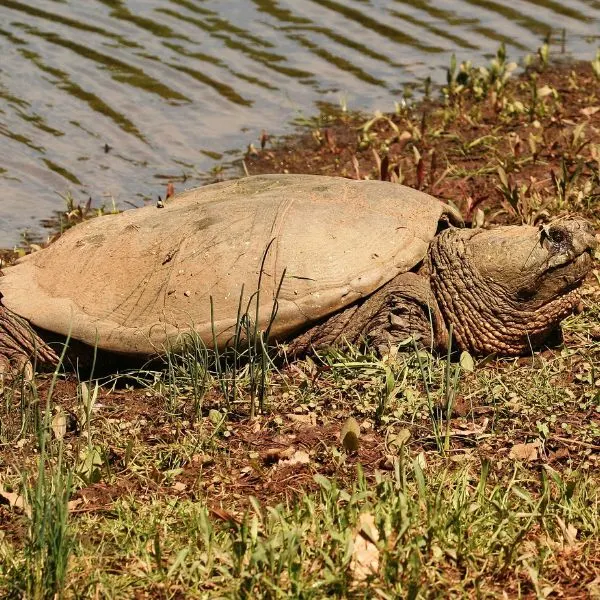
- Experience level: Intermediate to Expert
- Family: Chelydrida
- Scientific Name: Chelydra Serpentina
- Other Names: Snapping Turtle, Snapper, Eastern Snapping Turtle
- Average Adult Size: 8 to 20 inches
- Life Span: 30 – 50 years
- Average Price Range: Approximately $40 to $120
- Conservation Status: Least concern
The Common Snapping turtle can inhabit all sorts of water bodies, such as rivers, lakes, and marshes. This turtle can also tolerate brackish water on occasion. They prefer slow-moving waters with sandy or muddy bottoms.
When they find the perfect place to stay, the Snapping turtle will settle into the mud and wait for prey to ambush. Snapping turtles don’t often bask, but if the temperatures get cool enough they will find a place out of the water to warm up.
On land, these turtles can be very aggressive. They will warn you with hissing and attempted strikes. If they land a bite, they can cut through flesh and cause lacerations, so it’s best not to approach these turtles.
Snapping turtles have relatively small carapaces compared to their bodies. You may also see three ridges on the upper shell, though they fade in older turtles. Their legs are large and stick out, their tail is nearly as long as the shell, and the plastron hardly covers anything.
Their upper shell is olive, brown, or near black. Since they spend so much time in the water, their shell is frequently covered in mud and algae. Their skin can range from yellow to brown, and it’s covered in warty bumps.
Snapping turtles are omnivores, though they prefer meat. They will eat anything they can get into their jaws. Foods range from fish, amphibians, insects, crayfish, other turtles, and rarely waterfowl.
Spotted Turtles in Massachusetts
9. Spotted Turtle

- Experience Level: Intermediate to Expert
- Family: Emydidae
- Scientific Name: Clemmys guttata
- Other Names: Polka-dot turtle, “Spotty”
- Adult Size: 4 to 5 inches
- Life Span: Males up to 65 years; females up to 110 years
- Average Price Range: $200 to $300
- Conservation Status: Endangered
Spotted turtles are a small species of semi-aquatic turtle that turtle collectors desire. Their black shells have a high dome and have yellow, orange, or reddish spots. Spottys can have as few as a single dot, or they can have over a hundred on their carapace.
Their plastron is typically tan or yellow with black patches on each scute. Their skin is dark brown to black with orange or red on the underside.
Spotted turtles are semi-aquatic and spend plenty of time wandering through the dense vegetation they call home. Bogs, swamps, flooded meadows, small ponds, and meandering, woodland streams are potential Spotted turtle habitats.
These turtles are endangered because of habitat loss, pollution (they are quite sensitive to pollution), and human encroachment.
Spotted turtles are omnivores though they prefer live prey such as spiders, slugs, fish, snails, insects, and worms.
Wood Turtles in Massachusetts
10. Wood Turtle
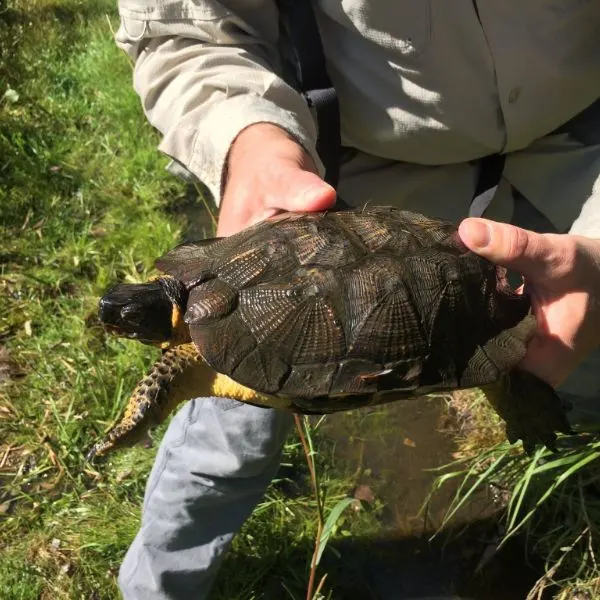
- Experience Level: Intermediate
- Family: Emydidae
- Scientific Name: Glyptemys insculpta
- Other Names: N/A
- Adult Size: 5.5 to 9 inches
- Life Span: 40 to 60 years
- Average Price Range: $250 to $500
- Conservation Status: Endangered
The Wood turtle is a unique turtle endemic to North America. These turtles are unfortunately endangered, but they can be found in Massachusetts.
Wood turtles are gorgeous animals that look like they were caringly sculpted by gifted hands. The carapace has ridged growth rings, the scutes are slightly pyramidal, and the color looks like stained, polished, aged wood.
The Wood turtle’s skin can be varying shades of black, grey, brown, red, and/or orange. Their legs are often brighter colored than the heads of these turtles, giving them the nickname “redleg” turtle.
These turtles not only have good looks but they are intelligent too. Who says you can’t have looks and smarts? While on land the Wood turtle has figured out how to bring food to itself.
When they are hungry, they will do a “dance” and stomp the ground with their feet and shell. The sound makes the worms think it’s raining. The worms will then emerge from their earthen tunnels where the turtle is able to gobble them up.
Wood turtles spend time in water and on land, but they don’t travel far from a water source. Woodlands, damp meadows, small streams, bogs, and wet fields are all places the Wood turtle will call home.
Aside from worms, Wood turtles will also eat caterpillars, insects, mollusks, berries, fungi, and other vegetation.
Pond Sliders in Massachusetts
11. Red Eared Slider

- Experience level: Beginner
- Family: Emydidae
- Scientific Name: Trachemys scripta elegans
- Common Name: Pond slider, Red-eared terrapin, Water slider
- Average Adult Size: 6 – 8 inches
- Life Span: 20 to 40 years
- Average Price Range: approximately $30 to $100
- Conservation Status: Least concern
The Red Eared Slider is a species native to the southeast part of the nation. In Massachusetts, Red Eared Sliders have been introduced, and they have become an invasive species.
These turtles are not only popular in the United States, but they are also trendy worldwide. Due to this fact, the Red-eared slider is the most traded turtle species in the world.
They are actually listed as one of the most invasive species in the world. Red Eared Slider owners probably didn’t realize what they were getting into when they bought the tiny, cute turtle swimming up to meet them at the pet store.
Red Eared Sliders can easily get 7 or 8 inches long, and some surpass that length. Being an aquatic species, they need a lot of water, and they can be very messy, meaning a lot of clean up and potentially expensive equipment.
Red Eared Sliders can also live for 30 or 40 years. Owners that get frustrated release the turtles into the wild thinking it’s the right thing to do, but doing that can upset the delicate ecological balance.
Red Eared Sliders are aggressive toward other turtles. They can also survive in nearly any type of water, and they produce a lot of offspring.
The carapace on these turtles starts off brightly colored and patterned, but it fades as they age. The skin is olive, brown, or black in older individuals. They also have yellow, to reddish stripes on their head, neck, and limbs, with a pair of red ovals behind each eye.
These turtles are omnivores that will eat anything that’s edible, so wherever they are, they can make themselves at home.
Sea Turtles Found Around Massachusetts
All Sea turtles are endangered and illegal to own. It’s even unlawful to touch them when you see them coming on shore or in the water. Most sea turtles prefer warmer waters than are typical of the Massachusetts coast, but they can be spotted on rare occasions.
12. Atlantic Leatherback Sea Turtle
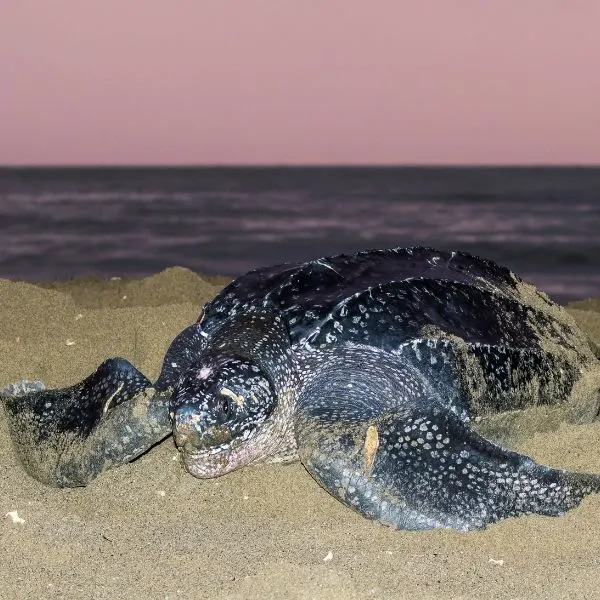
- Experience level: N/A, Illegal to own any sea turtle
- Family: Dermochelyidae
- Scientific Name: Dermochelys coriacea
- Other Names: Atlantic Leatherback, Leatherback
- Average Adult Size: 4 – 8 ft
- Life Span: 30 – 50 years
- Average Price Range: N/A
- Conservation Status: Endangered
The Leatherback Turtle is the largest species in the world, and they don’t even have a hard shell. As their name suggests, they have a leathery backs. These massive turtles can withstand the coldest waters of any turtle, can dive the longest (up to 4,000 feet), and have an extremely long migration.
These deep sea turtles migrate so far because they follow large groups of giant jellyfish, their favorite food. Leatherbacks will also eat sea squirts and sea cucumbers.
Leatherback turtles are dark grey to bluish black with white or pinkish spots. The underside is white or cream colored.
They occasionally visit the waters off Massachusetts but they don’t nest on the shores there.
13. Green Sea Turtle

- Experience level: N/A, Illegal to own any sea turtle
- Family: Cheloniidae
- Scientific Name: Chelonia mydas
- Other Names: Green Sea Turtle
- Average Adult Size: 3 – 4 feet
- Life Span: 50 – 70 years
- Average Price Range: N/A
- Conservation Status: Endangered
The Green Sea turtle is mostly an herbivore. They feed mostly on sea grasses and algae. Juveniles eat a wider variety of food as they need a lot of protein to grow big enough to ward off most predators.
The Green Sea turtle has a brown, olive, or black shell, and various colored scales. The skin between the scales is yellow, white, or cream colored.
These turtles are often seen swimming in coral reefs as they search for algae and other vegetation to eat.
14. Loggerhead Sea Turtle
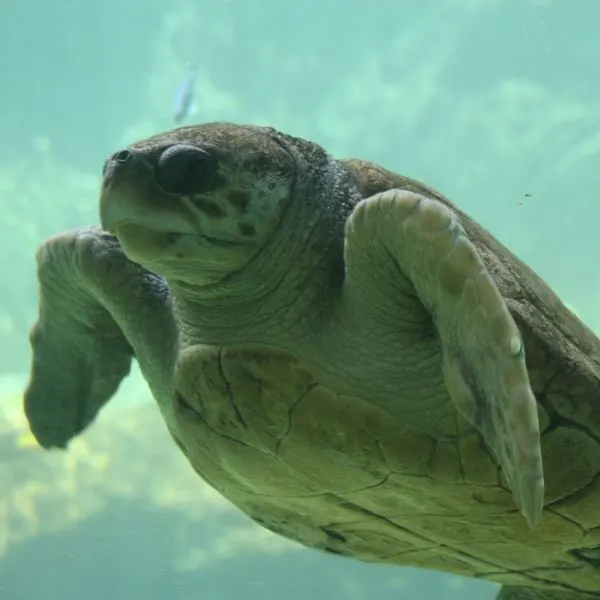
- Experience Level: N/A, Illegal to own any sea turtle
- Family: Cheloniidae
- Scientific Name: Caretta Caretta
- Other Names: Loggerhead
- Adult Size: 2.5 – 3.5 feet
- Life Span: 70 – 80 years
- Average Price Range: N/A
- Conservation Status: Endangered
Loggerhead Sea turtles are the most abundant of these open ocean turtles. They nest in warm, subtropical waters, and large concentrations can be seen in Southern Florida.
They can sometimes be seen swimming around Massachusetts as they search for clams and other hard shelled creatures. Loggerheads eat clams, crabs, whelks, sea urchins, conchs, and other crustaceans.
They have very strong jaws and dull, broad beaks made for crushing tough shells.
15. Kemp’s Ridley Sea Turtle

- Experience level: N/A, Illegal to own any sea turtle
- Family: Cheloniidae
- Scientific Name: Lepidochelys kempii
- Other Names: Atlantic Ridley, Tortuga Lora (Mexico)
- Average Adult Size: 24 – 27 inches
- Life Span: 30 years
- Average Price Range: N/A
- Conservation Status: Critically endangered
The Kemp’s Ridley Sea turtle is the smallest and the most endangered species on our list of sea turtles. It’s exceedingly rare to see these little guys this far north. They usually stay around the Gulf of Mexico in warmer waters.
Young Kemp’s Ridley turtles start out almost purple in color and gradually shift to an olive green with a light colored plastron.
These Sea turtles are the only turtles that nest during the day, all the other species prefer to come ashore in the dead of night.
Kemp’s Ridley turtles eat mostly crabs, shrimp, lobsters, and other crustaceans.
Wrapping up
We just went over 11 turtles living in Massachusetts and 4 different Sea turtle species that may be spotted in the waters around the state. As you can see, these turtles represent a varied lot. You have terrestrial Box turtles, semi-aquatic Wood turtles, and turtles such as the Painted turtle that don’t like to leave their watery habitat very much.
We hope you enjoyed this article and learned something about the turtles you can find in Massachusetts. If you did like this post, please leave us a comment below. Just a quick message really makes us feel good and encourages more great quality content!
Other nearby states
